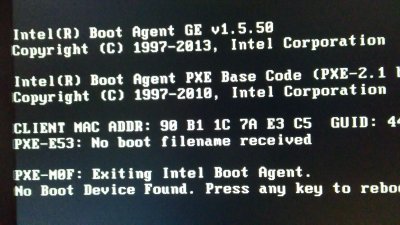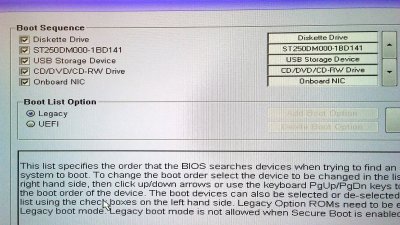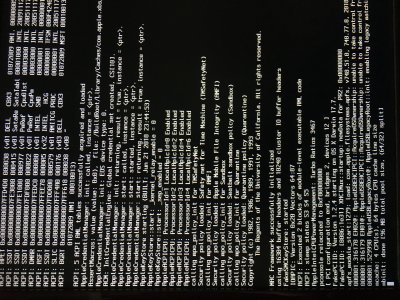Dell / Mitsubishi CMOS Battery Fails
I'm going to document the automatic, "switching back to Legacy BIOS" problem further because it's the third time this has happened now. I recently bought a 9010 SFF on Ebay for further testing. Installed High Sierra after setting the BIOS correctly for UEFI booting, everything went perfectly by following the guide in post #1. I then unplugged this Dell 9010 for a few days removed it from my test bench, and let it sit while working on other things. Tried to boot it up this morning and here's what I saw:

It didn't take long to figure out that the BIOS had automatically switched back to the default settings. So, it's caused by the bleeping CMOS battery again not holding a charge because this machine was unplugged from the wall for a couple of days.
Legacy and UEFI Boot Sequence of the Dell 9010 BIOS

Above is the default sequence you'll get when the CMOS battery fails
If you've followed the guide in post #1 of this thread, you set your Dell up for UEFI booting. When the battery fails, the BIOS changes you've made are lost. The result is that the Dell BIOS cannot see your macOS drive anymore to be able to boot it up. You won't reach the Clover Boot Menu screen or have any UEFI bootable drive options.

Here's how it should look when set to UEFI booting
This has never happened with any of the HP 6300/8300s I've owned that are about the same age, maybe even a year older than these Dell Optiplex computers. Maybe Dell got a bad batch of CMOS batteries that all fail after 4-5 years, I don't know. It may be the way the motherboard is designed. The only solution is to replace the battery with a fresh one, once you buy one of these refurb machines. If you keep the old CMOS battery you'll have to keep resetting the BIOS quite often and it will get very annoying quickly. So it looks like I'll need to create a step 0 - Replace the Bleeping CMOS Battery! and make it a mandatory step.
Here's an Amazon link to buy a 4 pack. They are very inexpensive and the Energizer brand is the best you can get.
https://www.amazon.com/dp/B00D8P5T0U/?tag=tonymacx86com-20
The lowest cost option is to buy a 2 pack on Ebay.com. These cost less than 70 cents each.
https://www.ebay.com/itm/2-Piece-Fr...010964&hash=item21372f0c48:g:JmQAAOSw-RFaX8G3
Whatever brand you choose to buy make sure it is model
CR2032 3V Lithium battery so it will work properly in the PC.
Even if you test the CMOS battery with a multimeter and it registers close to 3V it still may not be able to hold a charge and be a usable battery. You only need to watch the first 3 minutes to understand why battery testers don't work to verify whether a battery is good or not. Watch this video:
If you have any other PCs that are 7 years old or older you can replace those too as a preventative measure.






